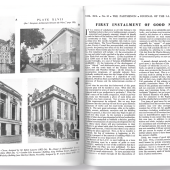Experts meet to discuss how to drive fire safety reforms

A recent roundtable saw a host of fire safety professionals meet to discuss the recommendations of the Grenfell Inquiry Phase 2 report and the path forward to reform fire safety.
Attended by the Institution of Fire Engineers (IFE), the Fire Industry Association (FIA), the Fire Sector Federation (FSF), the Fire Protection Association (FPA), the National Fire Chiefs Council (NFCC), CROSS-UK (Collaborative Reporting for Safer Structures), and the Health and Safety Executive as the Building Safety Regulator, the meeting sought to address the "pivotal role the sector can play in making people and buildings safer", including how the partner organisations can collectively support both government and industry in responding to the recommendations set out in Sir Martin Moore-Bick’s final Inquiry Report.
The attendees addressed key issues related to competency, professionalism, construction standards, the need for a central coordinating body, and the importance of advancing research and innovation in fire safety. They reviewed recommendations and identified opportunities for collaboration to "rebuild confidence" in the industry and "drive essential reforms."
A consensus emerged that a collaborative approach is essential to improving fire safety and building regulations.
Key points
Construction Standards
There was a focus on creating robust, consistent competency frameworks that clearly define the necessary knowledge and ethical standards for fire safety and construction professionals.
Competence and Professionalism
It is critical to set clear standards of competence throughout the sector to ensure accountability and consistency in built environments. Defining consequences for non-compliance is also necessary to uphold these standards.
Professional Standards and Accreditation
Promoting existing registration processes for fire engineers is key to maintaining high professional standards. Additionally, expanding accredited fire engineering programs in higher education institutions is vital for developing future expertise.
Building and Safety Regulatory Framework
Industry participants raised concerns about fragmented fire safety regulations across different government ministries. Integrating emergency response with fire safety strategies was seen as crucial for effective risk management, especially in complex building settings.
Central Coordinating Entity
The group emphasised the need for a central body to coordinate efforts, align objectives, and provide a unified approach to navigating the complexities of fire safety standards and regulations.
Communication
There was unanimous agreement on the importance of cohesive communication among leading fire safety organisations. This would help transparently convey the sector’s collective actions to both the government and the public. A united response to the recommendations from the Grenfell Tower Inquiry was highlighted as essential.
Fire Safety Innovation
The participants agreed to chart current research areas and identify opportunities for innovation. They emphasised the importance of developing a common research agenda focused on practical, high-impact solutions in fire safety.
All participants expressed their commitment to advancing regulations, improving professional competencies, and achieving the shared objectives discussed at the roundtable. Several collaborative projects were also proposed, with plans to revisit them at future discussions. Additional key organisations will be invited to contribute to this ongoing dialogue, said the FIA.







